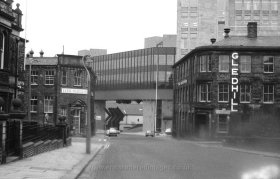[First published in 1984, since when the Halifax Building Society has turned full circle by converting itself into a bank].
In the world of finance, Halifax means its Building Society, the first in size in the country. It originates in the amalgamation, in 1928, of two societies, the Halifax Permanent (founded 1852) and the Halifax Equitable (founded 1871). Neither could claim to be a pioneer of the building society movement, although when the former was established, permanent societies were still sufficiently novel for the word to be included in its title. Nor did these two have a monopoly of the town's business, in which there have been at least six societies. Yet by 1928, they were, respectively, the largest and third largest building societies in the country. There must be something unusual about a town which could produce two such giants.
One reason could be its relatively isolated position. Surrounded to the south and to the east by a chain of hills, communications before the days of canals was practically confined to Leeds. In the nineteenth century the area was described as being in a "great waste and moors where corn and grass could scarcely be seen". But the hills had advantages in the form of numerous streams and rivers usable as water power and transport, as early as the fifteenth century. Halifax became an important centre for wool. In the 1560's, the decay of York's industry was attributed to Halifax's superior water power. Thereafter, growth was continuous to at least the end of the Napoleonic wars. At first, cloth went to Leeds by packhorse, where it was finished and repacked into individual customer lots before being sent by water to Hull for onward shipment to London or elsewhere. By 1700 transport to Leeds was by water, and after 1758 Halifax was connected directly to Hull by means of the Calder Navigation canal. The town was now independent of Leeds and could build its own dressing shops and dye works. It also created an export trade chiefly to Portugal, Turkey, Guinea and the Levant. Halifax seems to have been remarkably adept at avoiding the depressions of the wool industry. In the early days it moved into worsted goods, the rapid growth of which contributed greatly to the decline of the traditional English cloth. In the 1780's cotton manufacture was introduced into the area, followed by textile card making, carpets, and later wiredrawing and engineering.





